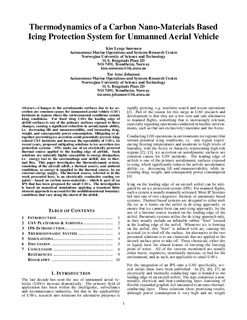Thermodynamics of a carbon nano-materials based icing protection system for unmanned aerial vehicle
Chapter, Peer reviewed
Accepted version
Permanent lenke
http://hdl.handle.net/11250/2470067Utgivelsesdato
2016Metadata
Vis full innførselSamlinger
Originalversjon
10.1109/AERO.2016.7500528Sammendrag
Changes to the aerodynamic surfaces due to ice accretion are common causes for unmanned aerial vehicle (UAV) incidents in regions where the environmental conditions sustain icing conditions. For fixed wing UAVs the leading edge of airfoil surfaces is one of the primary surfaces exposed to these changes, causing a significant reduction in aerodynamic ability, i.e. decreasing lift and manoeuvrability, and increasing drag, weight, and consequently power consumption. Mitigating or altogether preventing ice accretion could potentially prevent icing related UAV incidents and increase the operability of UAVs. In recent years, proposed mitigating solutions to ice accretion (ice protection systems - IPS) make use of an electrically powered thermal source applied to the leading edge of airfoils. Such solutions are naturally highly susceptible to energy dissipation, i.e. energy lost to the surroundings and airfoil, due to thermal flux. This paper investigates the thermodynamic system, consisting of the aircraft aifoil, a thermal source, and ambient conditions, as energy is supplied to the thermal source, by an external energy supply. The thermal source, referred to in the work presented here, is an electrically conductive coating (or paint) - based on carbon nano-materials - which is part of an IPS that has been proposed for small UAVs. The investigation is based on numerical simulations applying a transient finite element approach to account for the multidimensional boundary conditions that vary along the chord of the airfoil.
